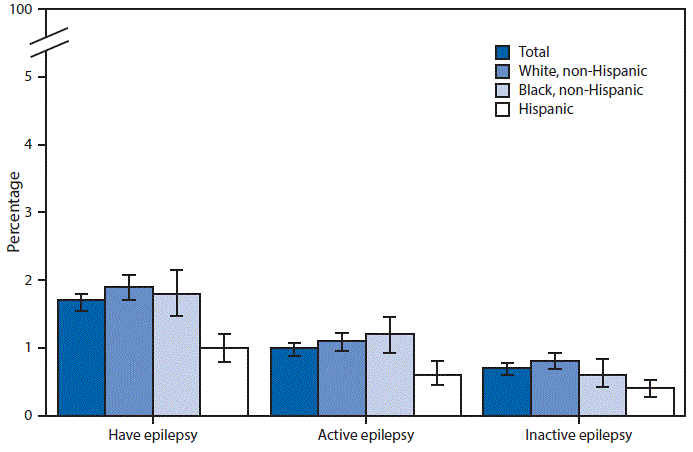QuickStats: Age-Adjusted Percentages* of Adults Aged ≥18 Years Who Have Epilepsy, by Epilepsy Status† and Race/Ethnicity§ — National Health Interview Survey, United States, 2010 and 2013 Combined¶
Weekly / June 17, 2016 / 65(23);611

* With 95% confidence intervals indicated with error bars.
† Respondents were asked, “Have you ever been told by a doctor or other health professional that you have a seizure disorder or epilepsy?” Persons responding “yes” were classified as having epilepsy. Those reporting having epilepsy who either were currently taking medication to control it, had one or more seizures in the past year, or both, were classified as having active epilepsy. Those with epilepsy who were neither taking medication for epilepsy nor had a seizure in the past year were classified as having inactive epilepsy.
§ Non-Hispanic white and non-Hispanic black categories were limited to adults categorized as of a single race. Hispanics might be of any race.
¶ Estimates are based on household interviews of a sample of the noninstitutionalized U.S. civilian population. Percentages were age-adjusted to the projected 2000 U.S. population as the standard population, by three age groups: 18–44, 45–64, and ≥65 years.
For the years 2010 and 2013 combined, 1.7% of adults aged ≥18 years (4.0 million) had epilepsy, 1.0% had active epilepsy, and 0.7% had inactive epilepsy. The prevalence of epilepsy and active epilepsy was significantly higher for non-Hispanic whites (1.9% and 1.1%, respectively) and non-Hispanic blacks (1.8% and 1.2%, respectively) compared with Hispanics (1.0% and 0.6%, respectively). The prevalence of inactive epilepsy was higher among non-Hispanic whites (0.8%) than Hispanics (0.4%). Non-Hispanic whites and non-Hispanic blacks did not differ significantly by epilepsy status.
Source: National Health Interview Survey. http://www.cdc.gov/nchs/nhis.htm.
Reported by: Mary Ann Bush, MS, mbush@cdc.gov, 301-458-4130; Sheila Franco.
Suggested citation for this article: QuickStats: Age-Adjusted Percentages of Adults Aged ≥18 Years Who Have Epilepsy, by Epilepsy Status and Race/Ethnicity — National Health Interview Survey, United States, 2010 and 2013 Combined. MMWR Morb Mortal Wkly Rep 2016;65:611. DOI: http://dx.doi.org/10.15585/mmwr.mm6523a8.
Use of trade names and commercial sources is for identification only and does not imply endorsement by the U.S. Department of
Health and Human Services.
References to non-CDC sites on the Internet are
provided as a service to MMWR readers and do not constitute or imply
endorsement of these organizations or their programs by CDC or the U.S.
Department of Health and Human Services. CDC is not responsible for the content
of pages found at these sites. URL addresses listed in MMWR were current as of
the date of publication.
All HTML versions of MMWR articles are generated from final proofs through an automated process. This conversion might result in character translation or format errors in the HTML version. Users are referred to the electronic PDF version (https://www.cdc.gov/mmwr) and/or the original MMWR paper copy for printable versions of official text, figures, and tables.
Questions or messages regarding errors in formatting should be addressed to mmwrq@cdc.gov.
- Page last reviewed: June 16, 2016
- Page last updated: June 16, 2016
- Content source:


 ShareCompartir
ShareCompartir